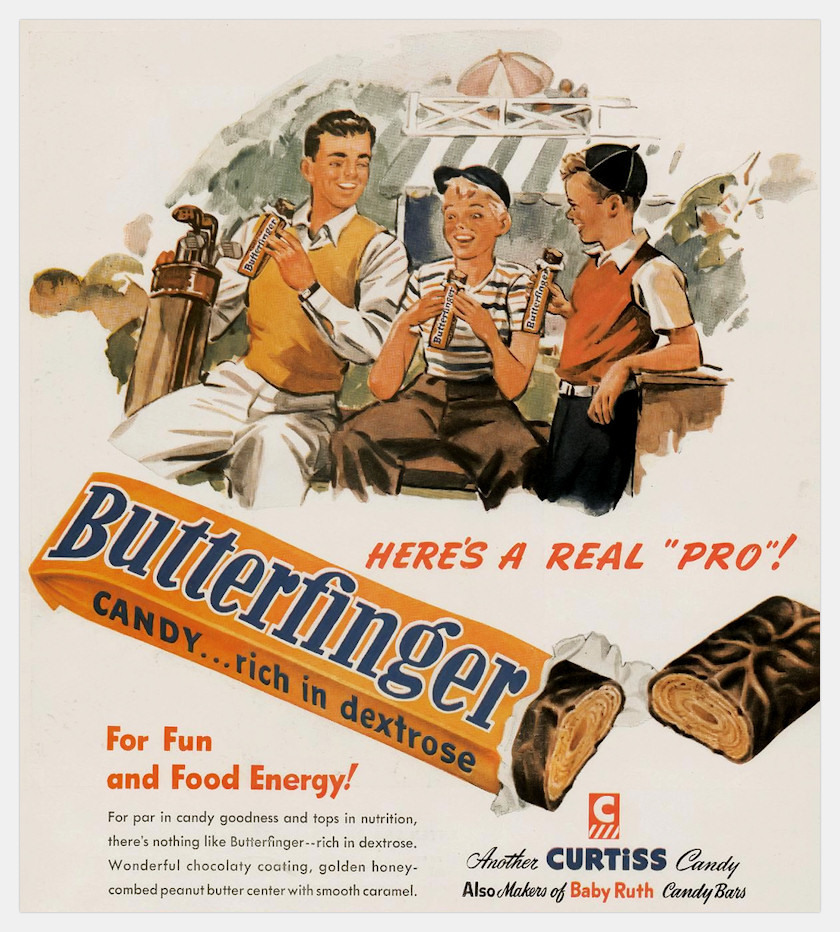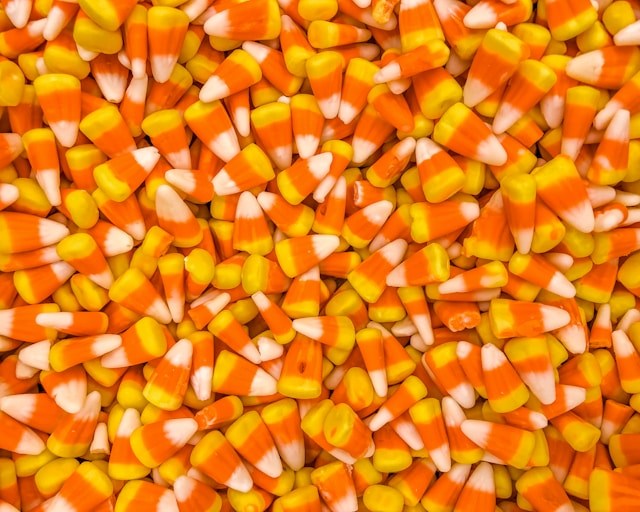Today in Tedium: Ok, so we're near Halloween, and I've been thinking a bit about candy. (Beats politics or, as it turns out, journalism.) In particular, I'm always drawn to the structural integrity of candy bars. On the surface, they are often stacked, solid, as thick as a smartphone. (It must be the nougat.) But they break down easily, with only a minimum of outward pressure. Which is why it's not a bad thing to put a smartphone in your pocket, but maybe not a Snickers. But I am drawn to one candy bar in particular, one that breaks with a minimum of pressure, despite feeling otherwise stiff. I'm of course talking about the Butterfinger, an unusual beast of candy, seemingly designed to break before you've even opened the wrapper. Today’s Tedium talks about candy bars, structural integrity, and Butterfingers. Yes. Really. — Ernie @ Tedium
1923
The year the Butterfinger, first developed by the Curtiss Candy Company, hit the market. The Chicago candy-making firm, formed in 1922, had two major hits immediately out of the gate—the Butterfinger and the Baby Ruth. While not the first of its kind—the Clark Bar beat it to the market by a little more than half a decade—it gradually became more popular, in part because of strong marketing, including the decision, early in its life, to make the naming of the Butterfinger a public contest. (Also, they dropped Baby Ruths and Butterfingers from airplanes as an ongoing publicity stunt, which makes my candy-bar OCD go nuts. I just know those Butterfingers did not survive ground impact in one piece.) It has gone through numerous owners over the past century, and has been owned at different times by some of the largest food-manufacturing firms—Standard Brands, Nabisco, and Nestlé.

The Butterfinger crew has always been solid at marketing. (Mike Mozart/Flickr)
Understanding how Butterfingers are made to better grasp their fragile nature
Maybe I’m strange, but I think more than most people about how brittle Butterfingers are.
They are one of the few food objects we buy, where there’s a 50/50 chance the candy bar will be broken before you even open it up. A trip to the 7-Eleven is likely to be filled with disappointment if you’re looking for a pristine, unbroken Butterfinger. Worse, if you try to grab a king-size Butterfinger, the odds of brokenness increase to 75%—which is perhaps why they started selling king-size bars in two separate pieces. It’s an admission that the structural integrity breaks down as the candy bars get larger.
The roots of this come down to the fact that, ultimately, a Butterfinger bar is a combination of hardened toffee and peanut butter, combined into one whole, solidified, but having a structural integrity that I would put halfway between balsa wood and particleboard. How did they nail down these structural properties in a candy bar?
I obviously don’t have hard data on this, but the breakage level of Butterfingers, while not eradicated, has improved somewhat since the candy bar’s ownership went from Nestlé to the Ferrero Group in 2018. That ownership change, one of many in the candy brand’s history, came with a controversial reformulation that seemed to please food critics more than actual consumers.
But looking back at the Nestlé-era design of this chocolate-coated treat surfaces a clip from the Food Network show Unwrapped, in which the company highlights the secrets of the Butterfinger manufacturing process. One of the key ones: At the time, at least, a key ingredient of Butterfingers was confectioner’s corn flakes, which gave it its crispy texture. (This no longer appears to be the case for the modern version, which uses peanut flour instead, presumably in a similarly flaked-up form. Another key difference between the old and new version: No molasses. Also, the new version looks a bit less day-glo orange.)
The real secret of the Butterfinger’s design is the use of flash-cooling on the hot candy. This is shown in the Food Network clip, around the 2:13 mark. Essentially, the sugary confection (a.k.a. the toffee) is mixed together in a melty, heated-up form, then put onto a cold surface, at which point it’s mixed with the peanut butter and further cooled, to solidify it. The parts are then and then broken into pieces and covered in chocolate, taking their solid form.
By taking a hot, sticky-sweet material and then immediately cooling it, the candy turns solid, but in a way that leaves in air pockets. It’s crystallized, like glass, but somewhat porous, like lava hardened after being quickly cooled by the earth’s atmosphere.
While not working at quite the same extremes, the manufacturing process of the toffee used in Butterfingers is not dissimilar to tempered glass, which is created using a combination of high heat and rapid cooling. But unlike Butterfingers, tempered glass has a reputation of being more durable, not less—likely because the tempering process of tempered glass works at far greater extremes than a Butterfinger bar ever does.
If you were to modify the flash cooling process so that the toffee had more time to harden and work out its air bubbles, it’s possible we could get a type of Butterfinger bar that might be strong enough to be used as a makeshift building material. But we have better options for that; there’s no need to replace plywood with blocks of peanut butter toffee.
If you find weird or unusual topics like this super-fascinating, the best way to tell us is to give us a nod on Ko-Fi. It helps ensure that we can keep this machine moving, support outside writers, and bring on the tools to support our writing. (Also it’s heartening when someone chips in.)
We accept advertising, too! Check out this page to learn more.
How a chef recreates Butterfingers in a kitchen
Not that this is necessarily easy to pull off. Back in early 2020, mere weeks before COVID-19 made the world a hellscape, and mere months before the magazine faced an internal reckoning that led to the departure of many personalities in the above video, chef Claire Saffitz attempted to recreate Butterfingers in the Bon Appétit test kitchen.
The nice thing about this kind of video is that you can see the thought process that might lead to the creation of this kind of candy bar before it’s been industrialized and put into a machine. Saffitz watched the same video I linked above, and you can see how it helped her nail down the final result.
Saffitz had no idea how they were made at the start, but in a matter of days, she figured it out.
She tested numerous methods, struggling at first to have enough room to work with the toffee before it hardened. Nailing the combination of the toffee and the peanut butter was actually somewhat difficult. Notably, unlike the Nestlé factory, she used feuilletine, a similarly flaky material made from crêpes, and Saffitz mixed the feuilletine with the toffee, rather than the peanut butter. It took her multiple days and a lot of experimentation, but she got pretty close!
91%
The percentage of U.S. consumers aware of Butterfingers, according to Statista. That’s only slightly behind its sister brand, the Crunch bar, but more popular than Almond Joy and Baby Ruth. Clark Bars and 5th Avenues do not appear on the list, despite each being similar in concept.
How different is a Butterfinger from its peanut-buttery, toffee-like competitors?
The texture of a Butterfinger bar is a bit different from a Clark Bar or a 5th Avenue bar, despite their respective surface similarities.
Each of these are peanut-buttery (and similar in texture), but a Butterfinger is more crystallized and less flaky. All three candy bars, at least prior to the 2018 reformulation, used a similar creation process, with minor differences. Despite having the flakiest texture, 5th Avenue doesn’t use corn flakes, but still uses molasses. Meanwhile, Clark Bars, which predate their more popular competitors, use both, and tend to be a bit more molasses-forward. As the video above shows, the process of manufacturing a Clark Bar is somewhat less automated than the Butterfinger, though who knows if that’s still the case.
As Candyblog notes, the Clark Bar has seen its share of reformulations over the years, and now uses more natural ingredients than in the past. (It has also struggled with ownership issues, after its parent company Necco went bankrupt in 2018. While it has a lower profile, it’s still being made.)
The differences in process, however subtle, can lead to dramatically different results. Butterfinger, for years, used a milk chocolate variant that you could very much tell was not actually milk chocolate. Meanwhile, 5th Avenue tends to taste a little creamy with less-uniform toffee flakes.
Some might argue that the reason Butterfinger is the more successful of the three bars might be due to advertising. I might also argue that it is a more mainstream take on the candy bar concept, with fewer rough edges and a more distinct flavor. It tastes more artificial, but that makes it feel more of its own thing.
For better or worse, the most popular candy bar in the flaky peanut butter genre is the one that, for years, looked the most artificial to the naked eye. And the one most likely to break with even a minor amount of pressure was put on it.
Obviously, the reason for this is that the Clark Bar never had a chance to win over Bart Simpson.
“Look—I love Clark Bars. People around our company love them. But the public isn’t buying them.”
— James Grubiak, a senior vice president at Leaf, Inc., discussing the company’s 1990 decision to stop making Clark Bars. The Clark Bar has fallen in and out of production over the past 30 years, falling to numerous owners, some of which have been more stable than others. It reminds me of what happened to Hydrox—a cookie brand created before Oreo, but lost to a later competitor that offered basically the same product. (Neither here nor there, but Hydrox’s current owner is Leaf Brands, a company that built the cookie from a pair of abandoned trademarks. I bet if Clark fell out of ownership again, it’d be a great home for it.)

“Rich in dextrose.” They promoted the fact the thing was loaded in corn syrup as a health benefit! (via the Nestlé Tumblr page)
A weird fact I learned about candy corn from homemade Butterfinger recipes
In the process of my research into the fragility of Butterfinger bars, I ran across an interesting fact about trying to recreate Butterfingers in your own kitchen that I didn’t think fit into the above narrative, but is worth diving into separately. Simply put, one of the most popular ways to make homemade Butterfingers involves using candy corn. It apparently does a good job of recreating the flavor of a Butterfinger, if not the exact texture.
The nice thing about candy corn, in the context of this recipe, is that it includes most of the main ingredients of the toffee part of butterfingers. That makes it possible to greatly simplify the recipe for people who want to make Butterfingers at home. (Plus, the orange-and-yellow parts of candy corn make for a decent food-coloring match to the innards of Nestlé-era Butterfingers, even if the cornflakes, key to the texture, aren’t part of the recipe.)
Now, finding out that candy corn can be used as a key ingredient in a Butterfinger recipe is sort of like finding out that your favorite dessert is made of candle wax. (Fun fact: Despite its generic-seeming nature, it’s mostly sold by a single manufacturer, Brach’s.)
But there’s a method to the madness.

You’d be surprised what candy corn, an ingredient of DIY Butterfingers, are made out of. (Mary Jane Duford/Unsplash)
See, when broken down, candy corn is made of fondant and confectioner’s glaze. Another way of putting it: A piece of candy corn is essentially the candy form of the chalky icing used on wedding cakes, which is then covered in waxy insect secretions. Awesome.
Find that last part kind of gross? Well, you should stop eating Milk Duds, Whoppers, Raisinets, and jelly beans, because they all use it. You’ve been eating food-grade shellac all your life and didn’t even know it.
So, let’s spend a minute talking about shellac: The fact that so many candies use this is actually a significant problem for the globalization of candy. In India, for example, it’s likely to leave out entire classes of consumers, as shellac isn’t considered vegetarian. Periodically, as noted in this 2009 Scientific American piece, we’ve looked for alternatives to confectioner’s glaze, but given that it remains a surprisingly large industry to this day—a recent Business Insider video put the sector’s value at $167 million. (Ironically, shellac was discovered in India, and remains the largest manufacturer of the material.)
If you’re OK with all that, making your own Butterfingers at home is apparently way easier if you use melted candy corns as a base. Just note that shellac isn’t usually part of the ingredient list.
If I had to decide, life on the line, which crispy, peanut-buttery candy bar was my favorite, I’d most certainly vote for 5th Avenue. The texture is more nuanced and less like a congealed blob of peanut butter and toffee, as the Butterfinger is.
Hershey’s, notably, also makes the Zagnut, which is essentially a coconut-covered version of the Clark Bar. (They acquired it in the ’80s, but not the Clark bar.) One wonders what it would take to make Zagnuts a popular candy bar. (A redesign? A popular Zagnut-themed TikTok?)
Ultimately, though, I’m left to ponder the brokenness of the Butterfinger. This is a candy bar that is immensely popular, yet structurally deficient. If you ask me, it has competitors that are arguably better in every way. How weird we picked the option with the better marketing.
--
Find this one an interesting read? Share it with a pal!
Are you a Butterfinger person, a fan of Clark Bars, or into 5th Avenues? I have a poll on Mastodon about this, if you’re curious.





